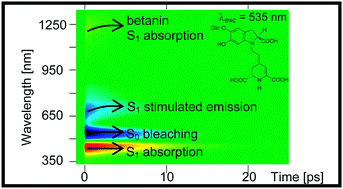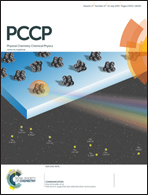Time-resolved spectroscopy of the singlet excited state of betanin in aqueous and alcoholic solutions†
Abstract
The photophysical properties of betanin in aqueous and alcoholic solutions were determined at room temperature using ultrafast UV-vis-NIR transient absorption spectroscopy (λexc = 535 nm). Its S1 → Sn (n > 1) absorption bands appear with maxima at about λ ∼ 450 and 1220 nm. The short betanin S1 state lifetime (6.4 ps in water) is mainly determined by the efficient S1 → S0 radiationless relaxation, probably requiring a strong change in geometry, since the S1 lifetime grows to 27 ps in the more viscous ethylene glycol. The fluorescence quantum yield is very low (Φf ∼ 0.0007 in water), therefore this deactivation path is of minor importance. Other processes, such as S1 → T1 intersystem crossing or photoproduct formation, are virtually absent, since full S0 ← S1 ground state recovery is observed within tens of picoseconds after photoexcitation. The observed fast light-to-heat conversion in the absence of triplet excited state formation supports the idea that betanin is a photoprotector in vivo.


 Please wait while we load your content...
Please wait while we load your content...